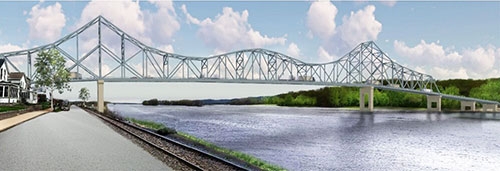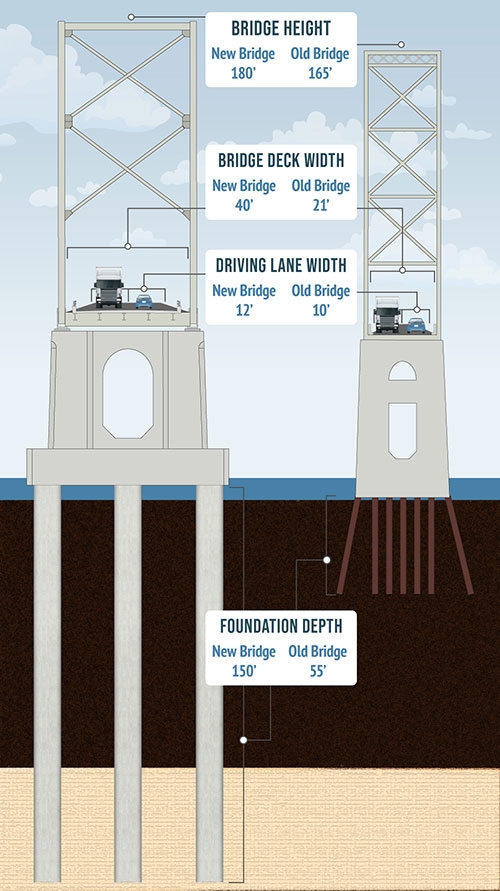You are here
Home ›Iowa DOT shares some initial detail insight into the Black Hawk Bridge replacement project as preliminary work gets underway

New Black Hawk Bridge design ... At first glance, the drawing above of the bridge that will be replacing the iconic Black Hawk Bridge at Lansing is very similar in its design, something that the Departments of Transportation (DOT) in Iowa and Wisconsin took note of in drawing feedback from area residents in regard to the new bridge design. While keeping a similar design, the most notable differences with the new bridge will be in safety and improved navigation, both on the bridge and below it. The image below shows that the new bridge will be nearly twice as wide as the current Black Hawk Bridge (40’ in comparison to 21’), not only allowing for driving lanes that will each be two feet wider, but also for safety shoulders for use in the event of emergency situations. The foundation of the bridge will also be anchored nearly three times as deep as the current bridge, allowing for a foundational base anchored in the rock layer beneath the surface (as pictured at the bottom of the image below). The new bridge will also be taller at its highest structural point. Images courtesy of the Iowa Department of Transportation.

The Mississippi River bridge connecting Iowa Highway 9 in Lansing to Wisconsin Highway 82 in rural Crawford County, WI stands as an icon for the region. A new icon is in the works to replace this aging structure and improve safety and mobility as motorists and river enthusiasts move around the area.
The cantilever Black Hawk Bridge structure has served the area since 1931 with a closure from 1945 to 1957 when the crossing was damaged by ice dams. Depreciation over time and changing vehicle size and traffic patterns now call for a new, wider, safer crossing.
Working with area residents and interest groups through public meetings and other outreach efforts, the Iowa and Wisconsin Departments of Transportation are proud to get started on a new, safe, functional and beautiful bridge that will serve the area for generations. Kraemer North America, LLC headquartered in Plain, WI was awarded the bid following a special bid letting in early August.
Federal funding will cover approximately 80 percent of the $140 million cost of the bridge. The states of Iowa and Wisconsin will evenly split the remaining costs.
Preliminary work and equipment have already begun to appear in the project area and will continue at an increased rate as September and October unfold. After the construction crews settle in, the new year (2024) should see the new bridge gradually rise out of the water as each piece is finished from deep below the Mississippi riverbed to the tall peaks of the new steel truss.
The Iowa Department of Transportation (DOT) has offered the following Question & Answer (Q&A) series in regard to the bridge replacement:
Why does the current bridge need to be replaced?
A lot of data has been collected related to the current structure. Here are just a few conclusions from the analysis of this data:
• Structural condition - The current bridge rates as low for its structure. This limits commercial traffic and is impacting freight movement in the region.
• Geometry - The tight turn where Iowa 9 intersects in Lansing makes it difficult for truck traffic, also impacting freight movement in the region.
• Safety - The deck is narrow at only 21 feet and has no shoulders. This gives no room for motorists with mechanical trouble to pull over safely. Any crash or other incident will likely close the bridge completely.
• Ride - The old bridge has a steel grate deck that provides a very rough ride. The steel grates are difficult for DOT winter maintenance crews to remove snow and ice.
• Navigation - The 650-foot width of the navigation channel is problematic for barges.
What can be expected from the new bridge?
In addition to collecting a lot of data about the current bridge, the DOT also held several meetings and listened to area residents as they shared what is important to them about the old bridge and what they expect with the new one.
• Design - The existing bridge is a beloved structure in the region. The new bridge was thoughtfully designed to mimic the look of the existing bridge.
• Geometry - The Iowa 9 intersection in Lansing will be upgraded to allow for safer truck travel.
• Safety - The new bridge will have wider lanes and eight-foot-wide shoulders (40 feet total), greatly increasing safety.
• Ride - The new bridge will have a smooth, concrete deck that will protect the superstructure from winter maintenance treatments.
• Navigation - The navigation channel will be increased to 750 feet, making it easier for barges to get through the area.
When will the work on the bridge take place?
Some environmental work is underway now to catalog and relocate mussels in the Mississippi River near the old bridge. Other preliminary work may begin this year. The bulk of the construction work for the new bridge will take place alongside the old bridge beginning in 2024 and running through 2026. The old bridge will remain in use during this time. In 2026, the roads that connect to the new bridge will be constructed and there will be a few weeks when traffic will be detoured as those connections are made. The new bridge is expected to be fully functional in 2027 and the old bridge will be removed.
How can more be learned throughout this process?
• The Iowa and Wisconsin DOTs have developed a website where those interested can get the latest information and sign up to receive progress updates via email.
• Interested individuals can also follow posts on the project’s Facebook page at https://www.facebook.com/LansingBridge/.
• Emails can also be sent to the project team at DOT-Iowa9bridge@iowadot.us.

